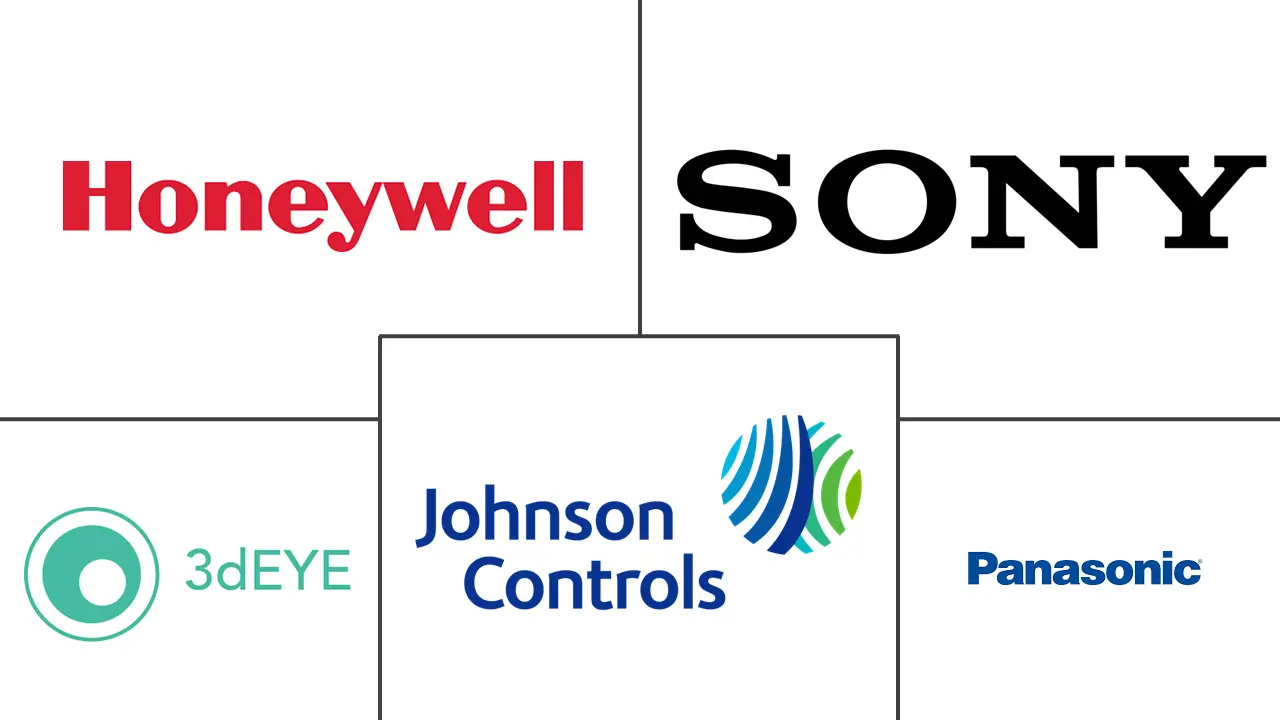IP Camera Market Size and Share
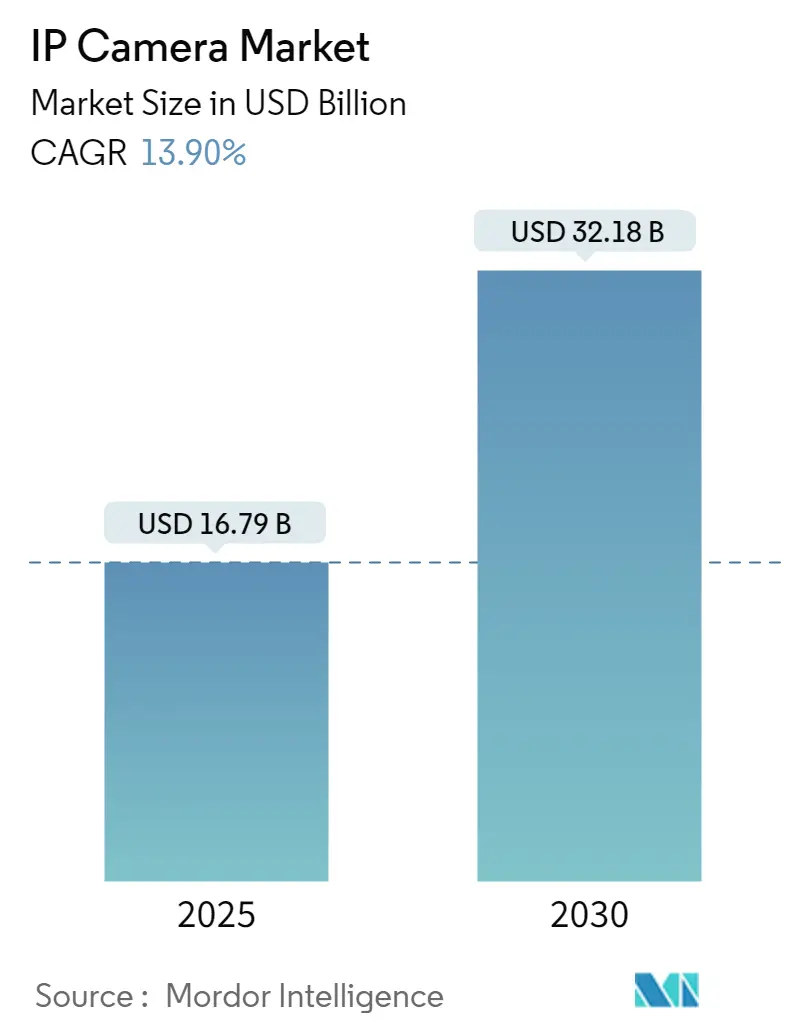
IP Camera Market Analysis by Mordor Intelligence
The IP Camera Market size is estimated at USD 16.79 billion in 2025, and is expected to reach USD 32.18 billion by 2030, at a CAGR of 13.9% during the forecast period (2025-2030).
• An IP camera, or internet protocol camera, is a digital security camera that receives and sends video footage via an IP network. Unlike analog closed-circuit television cameras, IP cameras do not need a local recording device, only a local network. Each IP camera is equipped with a processing chip that compresses the video footage as it is recorded. The higher the resolution of the camera, the more data each video recording contains, which requires more storage space and bandwidth for transmission.
• IP cameras boast superior image quality, offering high-resolution videos and images. The use of digital technology allows for better clarity, sharpness, and color accuracy, enabling effective identification and analysis of events. High-definition (HD) and ultra-high-definition (UHD) resolutions ensure that crucial details are captured, enhancing surveillance capabilities. By connecting to the internet, users can view real-time footage from any location using a smartphone, tablet, or computer. Remote access facilitates immediate response to emergencies, allowing users to take appropriate action or notify authorities when necessary.
• The increasing demand for high-resolution video surveillance is a prominent market driver for IP cameras. As organizations and individuals prioritize safety and security, there is a growing need to capture clear and detailed images to enhance situational awareness. IP cameras, with their ability to provide high-resolution video footage, satisfy this demand by enabling better identification of individuals, objects, and events. This is particularly beneficial in critical applications such as airports, banks, and government institutions where accurate identification is vital.
• Unlike analog cameras that require complex wiring, IP cameras utilize existing network infrastructure, making installation simpler and more cost-effective. With Power over Ethernet (PoE) technology, a single cable can transmit both power and data, eliminating the need for separate power supplies. Additionally, IP cameras offer scalability, allowing for easy expansion of the surveillance system as needs evolve.
• However, high initial installation costs pose a challenge for budget-conscious consumers and businesses. Additionally, interoperability issues between different camera brands and software platforms limit seamless integration and compatibility.
• Further, the conflict between Russia and Ukraine will significantly impact the electronics and semiconductor industry. The conflict has already exacerbated the electronics and semiconductor supply chain issues and chip shortages that have affected the industry for some time. The disruption may result in volatile pricing for critical raw materials such as nickel, palladium, copper, titanium, and aluminum, resulting in material shortages. This, in turn, could impact the manufacturing of IP cameras.
Global IP Camera Market Trends and Insights
The Commercial Segment is Expected to Drive the Market's Growth
• IP cameras have become an essential tool for the retail sector. With their advanced features and connectivity, IP cameras offer a range of applications that enhance security, improve operations, and boost sales. In terms of security, IP cameras provide real-time monitoring, enabling retailers to prevent theft, detect suspicious activities, and maintain a safe environment. Additionally, these cameras can be integrated with video analytics software to identify shoplifting, analyze customer behavior, and optimize store layouts. Moreover, IP cameras enable remote monitoring, allowing retailers to monitor multiple locations simultaneously.
• The expansion of the retail market is likely to boost the growth of the studied market. For instance, according to the US Census Bureau, by the end of 2023, total retail sales in the United States reached approximately USD 7.24 trillion, an increase of around USD 1.5 billion from the year before.
• IP camera manufacturers have introduced wide dynamic range (WDR) technology and low-light performance capabilities to overcome challenging lighting conditions. WDR allows cameras to capture clear images in scenes with extreme variations in brightness, such as areas with bright sunlight and deep shadows. Low-light performance enables cameras to produce usable footage even in poorly lit environments.
• IP cameras have diverse applications in the BFSI (Banking, Financial Services, and Insurance) sector. They are used for surveillance and security purposes, allowing banks and financial institutions to monitor and record real-time activities, deter potential crimes, and ensure customer safety. They are also utilized for fraud prevention and investigation, providing clear video evidence in case of any fraudulent activities.
• Additionally, these cameras are employed for access control, monitoring employee behavior, and ensuring compliance with industry regulations. Moreover, IP cameras aid in risk management, as they can be integrated with analytics software to detect suspicious activities and potential threats.
• Further, the adoption of cloud-based solutions in the commercial sector in the studied market has increased significantly. Cloud storage and remote access allow users to conveniently store and access surveillance footage from anywhere, improving scalability and reducing infrastructure costs.
• With the increasing demand for real-time video analytics, edge computing is expected to play an important role in the future of commercial IP cameras. By processing data locally on the camera itself, edge computing reduces latency, bandwidth requirements, and reliance on cloud infrastructure, enabling faster response times and improved privacy.
• For instance, in April 2024, Ajax Systems launched its latest line of wired security IP cameras, offering high-definition surveillance and robust privacy protections. The models include the TurretCam, BulletCam, andDomeCamMini, each with different specifications. These cameras are claimed to be versatile, suitable for both indoor & outdoor use, and carry an IP65 rating. They offer secure, password-less authentication for a smooth and secure setup.
• These cameras can cater to various video surveillance requirements with various matrix types and lenses. Other features include an IR illumination range of up to 35 m, a customizable motion detection area, archive synchronization with system events, and a built-in digital microphone. Such innovations are anticipated to offer lucrative opportunities for the growth of the studied market.
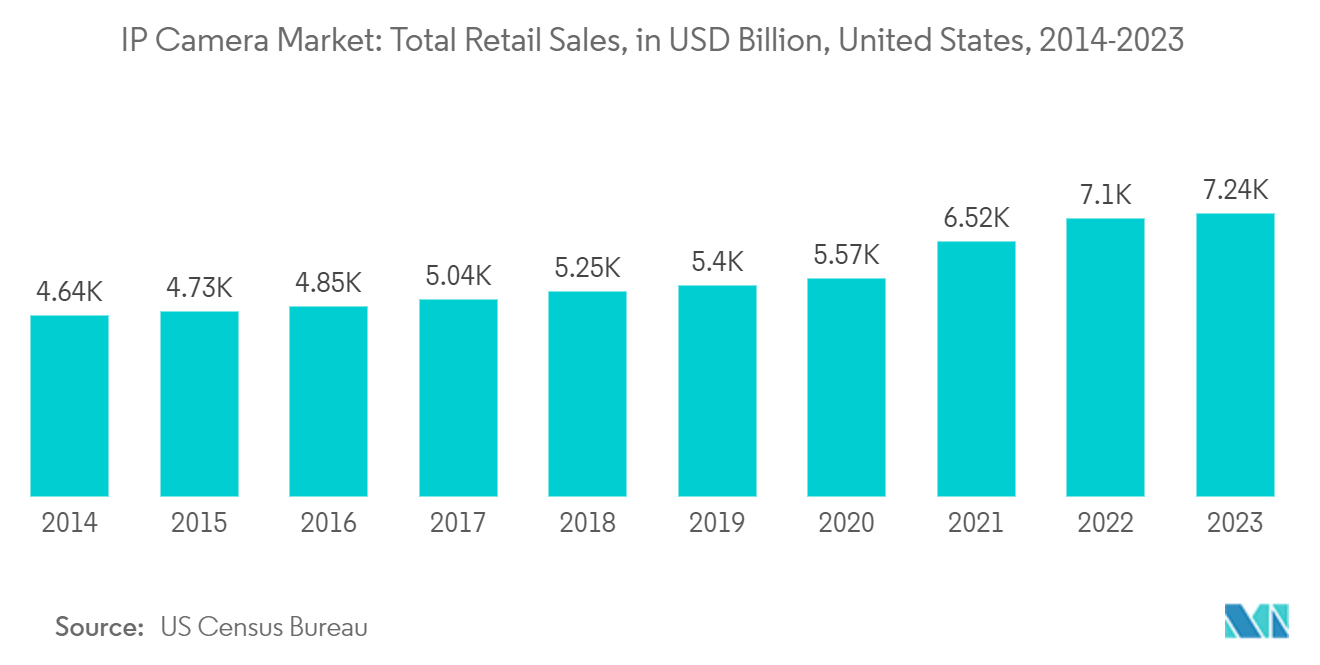
Asia-Pacific is Expected to Witness a High Market Growth Rate
• Asia-Pacific has emerged as a lucrative IP camera market due to factors such as rapid urbanization, increasing security concerns, and the need for advanced surveillance systems. Countries like China, South Korea, Japan, and India have been at the forefront of adopting IP camera technology, driving the market's growth.
• In Asia-Pacific, IP cameras are increasingly being integrated with artificial intelligence (AI) and analytics technologies. This integration allows for advanced video analytics, facial recognition, object detection, and behavior analysis, enhancing the effectiveness of surveillance systems.
• The demand for robust surveillance systems has increased with the rise in criminal activities and security threats. For instance, according to the National Police Agency (Japan), the total number of violent offenses known to the police in Japan increased from 49.72 thousand in 2021 to 52.7 thousand in 2022. In 2023, the total number of violent offenses known to the police in Japan amounted to approximately 58.47 thousand. IP cameras offer advanced features like real-time monitoring, remote access, and proactive alerts, making them suitable for enhancing security measures.
• Further, governments in Asia-Pacific are investing heavily in smart city projects, including deploying advanced surveillance systems. IP cameras play a crucial role in these projects, contributing to the growth of the market. The continuous advancements in IP camera technology, such as higher resolutions, improved low-light performance, and enhanced video analytics, are driving the market's growth. These advancements cater to the evolving requirements of businesses and organizations.
• The increasing construction activities have led to a surge in the demand for the studied market. For instance, China's 14th Five-Year Plan emphasizes new infrastructure projects in transportation, water systems, energy, and new urbanization. According to estimates, overall investment in new infrastructure during the 14th Five-Year Plan period (2021-2025) will reach nearly CNY 27 trillion (USD 3.74 trillion). The new plan accentuated nine key items for energy efficiency and green building development.
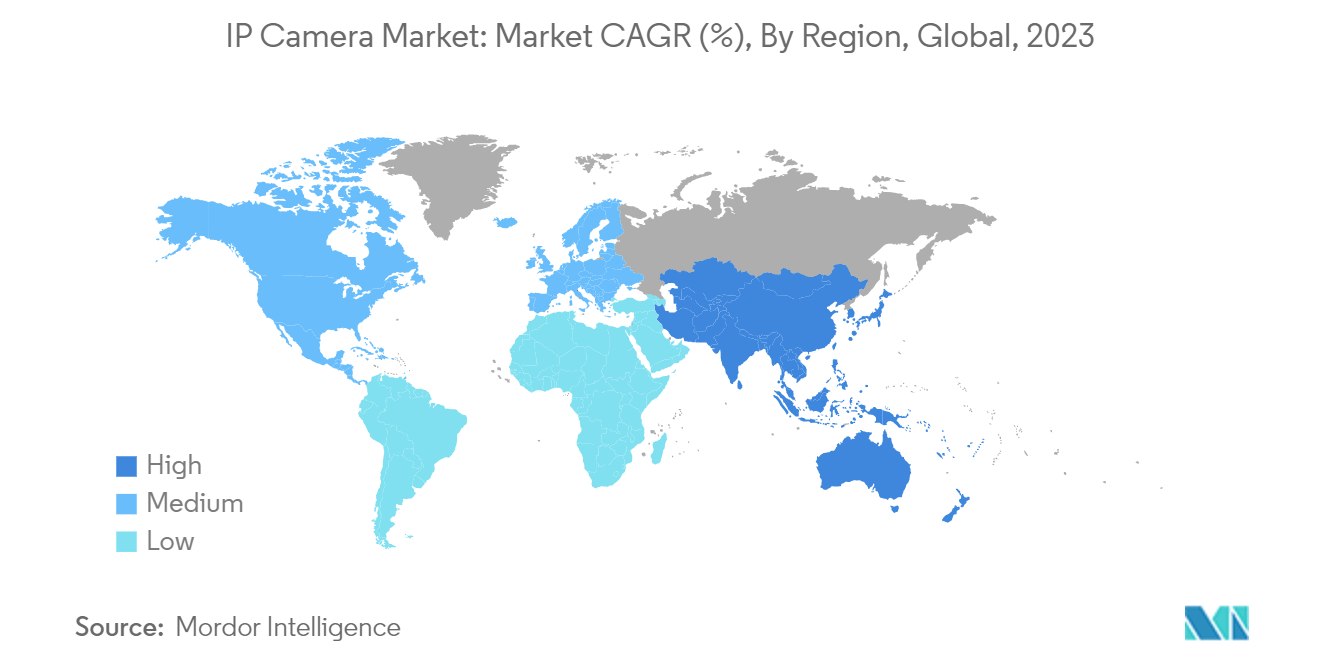
Competitive Landscape
The IP camera market is fragmented, with several prominent market players like Johnson Controls International PLC, Honeywell International Inc., 3dEYE Inc., Sony Corporation, Panasonic Corporation, Matrix Comsec Pvt. Ltd, etc. The market players are striving to innovate new products by way of extensive investments in R&D, collaborations, and mergers to cater to the evolving demands of consumers.
• January 2024 - Milesight, a prominent provider of innovative IP-based video surveillance solutions, and 3dEYE, a player in cloud-based video management, AI analytics, and automation, announced their strategic collaboration to deliver improved cloud video solutions to their security and monitoring industry customers. The partnership between 3dEYE and Milesightbrings together Milesight's advanced IP camera technology with 3dEYE's advanced pure cloud video AI platform, providing their customers with key advantages like scalable centralized monitoring, enhanced AI analytics to reduce false alarms, ease of deployment, and low total cost of ownership (TCO), etc.
• November 2023 - Matrix, a prominent player in security and telecommunications solutions, announced the launch of its Matrix Ruggedized Series IP Cameras, which are catered towards transportation surveillance. The cameras boast a back-illuminated CMOS sensor from the STARVIS Series, ensuring robust video quality even in extremely low-light conditions. Their rugged design is made to withstand shocks, vibrations, dust, impacts, and moisture, making them suitable for the challenging transportation environment.
IP Camera Industry Leaders
Johnson Controls International plc.
Honeywell International Inc.
3dEYE Inc.
Sony Corporation
Panasonic Corporation
- *Disclaimer: Major Players sorted in no particular order
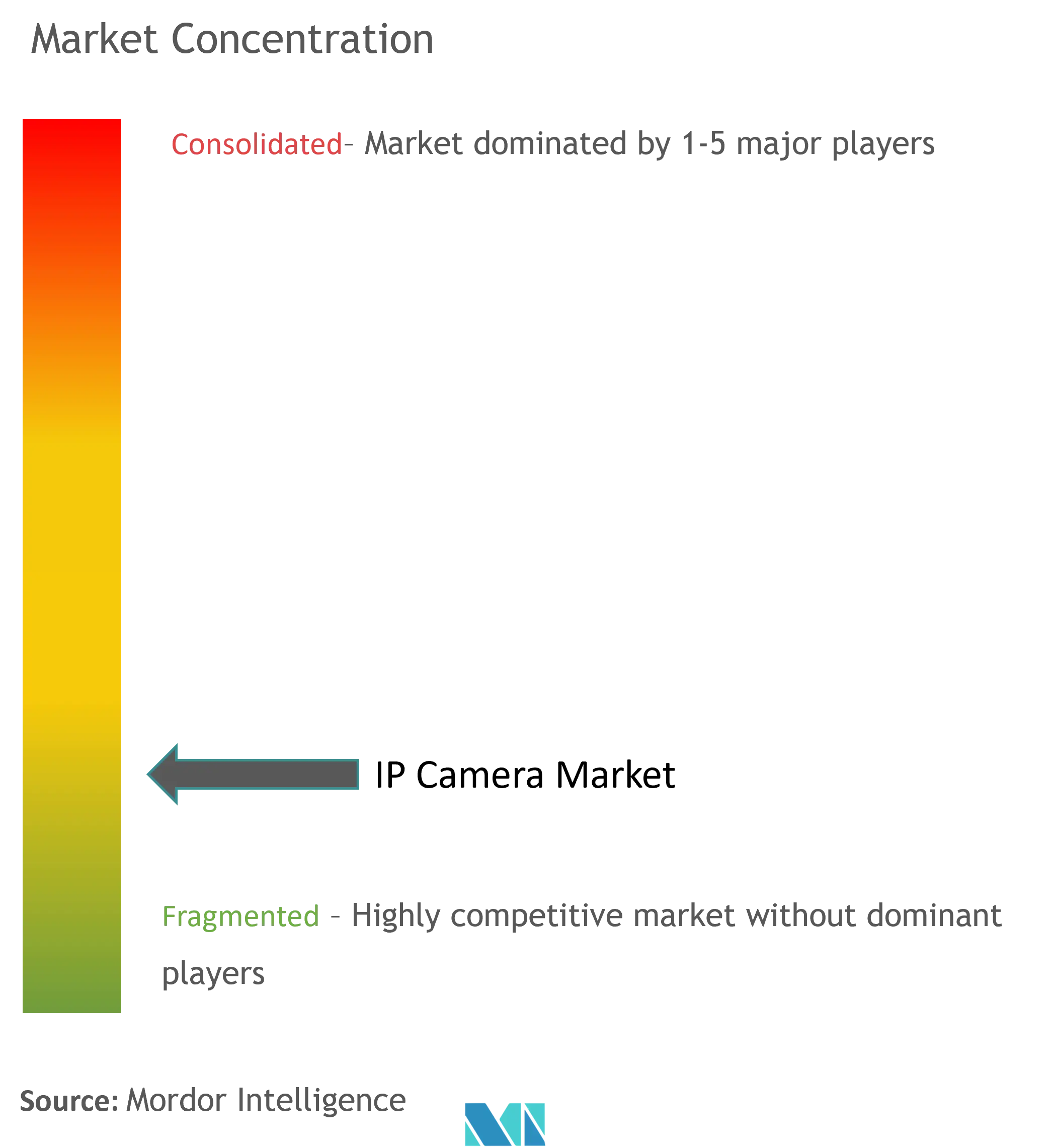
Recent Industry Developments
- February 2024 - Motorola Solutions acquired Silent Sentinel, a provider of specialized, long-range cameras based in Ware, United Kingdom. Equipped with highly accurate detection capabilities, Silent Sentinel's cameras are claimed to be capable of identifying anomalies from up to 20 miles away (30 km) to extend the perimeter of security and support a faster, more informed response.
- January 2024 - Johnson Controls India unveiled new security cameras—Illustra Standard Gen3. This line of domestic security cameras is a testament to the company's commitment to India's Make in India initiative. Designed to meet security requirements across industries, the new line is claimed to encompass access control, cloud solutions, video surveillance, and intrusion detection. These cater to various sectors, including defense, private enterprises, government, airports, and transportation projects.
Global IP Camera Market Report Scope
We have tracked the revenue generated from selling IP cameras offered by different market players for various applications for market estimation. The market trends are evaluated by analyzing significant market players' investments in product innovation, diversification, and expansion efforts. Further, the advancements in image quality, video analytics, connectivity, artificial intelligence & machine learning algorithms, and advancements in cybersecurity are also crucial in determining the growth of the studied market.
The IP camera market is segmented by type (fixed, Pan-Tilt-Zoom (PTZ), and Varifocal), end-user industry (residential, commercial, industrial, government, and law enforcement), geography (North America, Europe, Asia-Pacific, Latin America, and the Middle East and Africa). The market sizes and forecasts are provided in terms of value (USD) for all the Above Segments.
| Fixed |
| Pan-Tilt-Zoom (PTZ) |
| Varifocal |
| Residential |
| Commercial (BFSI, Education, Healthcare, Real Estate, Retail, and others) |
| Industrial |
| Government and law enforcement |
| North America |
| Europe |
| Asia |
| Latin America |
| Middle East and Africa |
| Australia and New Zealand |
| By Type | Fixed |
| Pan-Tilt-Zoom (PTZ) | |
| Varifocal | |
| By End-user Industry | Residential |
| Commercial (BFSI, Education, Healthcare, Real Estate, Retail, and others) | |
| Industrial | |
| Government and law enforcement | |
| By Geography*** | North America |
| Europe | |
| Asia | |
| Latin America | |
| Middle East and Africa | |
| Australia and New Zealand |
Key Questions Answered in the Report
How big is the IP Camera Market?
The IP Camera Market size is expected to reach USD 16.79 billion in 2025 and grow at a CAGR of 13.90% to reach USD 32.18 billion by 2030.
What is the current IP Camera Market size?
In 2025, the IP Camera Market size is expected to reach USD 16.79 billion.
Who are the key players in IP Camera Market?
Johnson Controls International plc., Honeywell International Inc., 3dEYE Inc., Sony Corporation and Panasonic Corporation are the major companies operating in the IP Camera Market.
Which is the fastest growing region in IP Camera Market?
Asia Pacific is estimated to grow at the highest CAGR over the forecast period (2025-2030).
Which region has the biggest share in IP Camera Market?
In 2025, the North America accounts for the largest market share in IP Camera Market.
What years does this IP Camera Market cover, and what was the market size in 2024?
In 2024, the IP Camera Market size was estimated at USD 14.46 billion. The report covers the IP Camera Market historical market size for years: 2019, 2020, 2021, 2022, 2023 and 2024. The report also forecasts the IP Camera Market size for years: 2025, 2026, 2027, 2028, 2029 and 2030.
Page last updated on:
IP Camera Market Report
Statistics for the 2025 IP Camera market share, size and revenue growth rate, created by Mordor Intelligence™ Industry Reports. IP Camera analysis includes a market forecast outlook for 2025 to 2030 and historical overview. Get a sample of this industry analysis as a free report PDF download.
